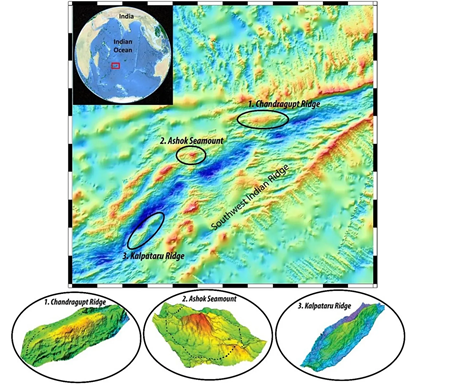Table of Contents
Kumki Elephant
Context: Andhra Pradesh has sought the help of the Karnataka Forest Department to tackle man-elephant conflict in the State.
About Kumki Elephant
- Kumkis are trained captive elephants used in operations to trap, rescue and tranquilise wild elephants.
- Their services are also utilised to rescue wounded elephants, and to lend support to the wild elephants that have difficulty standing.
- Kumki elephants are also used to help manage and drive wild elephants, thereby reducing damage to crops, human habitation and the potential loss of both human and elephant lives.
- These elephants can also be deployed for forest patrolling and rescue operations,”
- Kumki elephants are also the ‘caretakers’ of wild elephants that are tranquilised.
| About Asian Elephants |
|
| Facts |
|
Renaming of Geological structures in Indian Ocean
Context: Three underwater geographical structures located in the Indian Ocean have been awarded names proposed by India.
More in News
- Two structures are named after rulers of the Mauryan dynasty, the Ashoka Seamount and the Chandragupta Ridge.
- Kalpataru Ridge is the third structure for which the International Hydrographic Organization (IHO) and UNESCO’s Intergovernmental Oceanographic Commission (IOC) have recently awarded names originally proposed by India.
- In all, there are now seven structures in the Indian Ocean named mainly after Indian scientists or bear names proposed by India in this region of the Indian Ocean.
- All the three recently named structures were discovered by oceanographers from the NCPOR, Goa.
- These are located along the Southwest Indian Ridge area of the Indian Ocean and were discovered during an international survey exploration programme.
About NCPOR
- The National Centre for Polar and Ocean Research (NCPOR) is India’s premier R&D institution responsible for the country’s research activities in the Polar and Southern Ocean realms
- It was established as an autonomous Research and Development Institution under the Ministry of Earth Sciences on 25 May 1998.
- It is the nodal agency for planning, promotion, coordination and execution of the entire gamut of polar and southern ocean scientific research in the country as well as for the associated logistics activities.
- NCPOR is responsible for the management and upkeep of the Indian Antarctic Research Bases “Maitri” and “Bharati”, and the Indian Arctic base “Himadri”

| International Hydrographic Organization (IHO) |
|
Protected Areas in News
Nameri Tiger Reserve
- It is situated in the northern part of the Sonitpur district of Assam, along the foothills of Arunachal Pradesh.
- The habitat is biologically rich and is famous for the white-winged wood duck.
- The Nameri National Park constitutes the core of NTR, which is bound by rivers, viz. Jia-Bhoreli in the west and Bor-Dikorai in the east.
- The Pakke Tiger Reserve of Arunachal Pradesh is in the North and the habitat is contiguous.
- Major Fauna: Tiger, sambar, barking deer, wild boar and bison.
Sonai Rupai Wildlife Sanctuary
- It is located in Sonitpur, Assam extending over the foothills of the Eastern Himalayan range.
- It was declared as a Wildlife Sanctuary in 1998.
- Sonai-Rupai got its name from a small river that flows through this area.
- During the rainy season, several wetlands known as “bheels” can also be seen.
Implications of Antitrust Case Verdict Against Google
Context: A US judge ruled that Google violated antitrust laws by spending billions to create an illegal monopoly as the world’s default search engine.
Implications of the Google Antitrust Ruling
- Legal Precedent: The ruling against Google could set a new precedent on how Big Tech firms conduct their business affairs, similar to the impact of the antitrust ruling against Microsoft nearly a quarter-century ago.
- Potential Remedies: The U.S. Department of Justice may propose remedies ranging from breaking up Google to eliminating exclusive agreements between Google and handset makers.
- Breaking up Google would fundamentally change the structure and nature of digital businesses, given Google’s integration with various digital services.
- Eliminating exclusive deals would immediately affect revenue streams for handset makers like Apple, which could lose billions of dollars from its exclusive agreement with Google.
- Impact on Handset Makers: Apple and Samsung may be disincentivized from developing their own rival search engines if the exclusive deals with Google are terminated.
- The removal of these deals could help consumers access alternative search engines, potentially fostering competition in the search engine market.
- Consumer Choice and Market Competition: Terminating exclusive agreements could allow consumers to explore alternative search engines rather than being limited to the pre-loaded Google search engine on their smartphones.
- The effectiveness of these alternative search engines will depend on their ability to scale and process data to optimise user experiences.
- Product Improvement and User Privacy: These changes could push Google to enhance its search engine, with a possible focus on improving user privacy.
- Competition might drive Google to innovate and create better products for users.
- Broader Impact on Big Tech: The ruling will influence ongoing antitrust cases against other Big Tech firms like Meta, Amazon, and Apple.
- It signals a potential shift in how monopolistic practices are addressed and regulated in the tech industry.
- Future Legal and Business Environment: The outcome of the remedies and the appeal process will shape the future legal and business environment for digital companies.
- This ruling underscores the importance of fair competition and could lead to more stringent regulatory scrutiny of Big Tech firms.
- Industry-Wide Changes: If exclusive agreements are eliminated, the digital services landscape could see significant changes, encouraging diversity and innovation among search engine providers.
- The ruling could catalyse a broader movement towards more competitive practices in the tech industry.
What’s Causing Antarctica’s Deep-Winter Heatwave
Context: For the second time in two years, a record-breaking heatwave is sweeping through Antarctica during its winter season.
More in News
- Ground temperatures have been 10 degrees Celsius higher than normal on average since mid-July, and up to 28 degrees higher on certain days.
- East Antarctica: Temperatures are currently between minus 25 degrees and minus 30 degrees Celsius, while deep-winter temperatures usually range between minus 50 degrees and minus 60 degrees Celsius.
Reasons for the Heatwave
- Weakening of the Polar Vortex: The polar vortex, which traps cold air over Antarctica, has been weakened by large-scale atmospheric waves.
- This disturbance allowed warmer air to enter the region, increasing temperatures.
- Sea Ice Reduction:
- The extent of Sea Ice: In June, the Antarctic sea ice extent was the second-lowest ever for that time of year, slightly more than the lowest extent recorded in June 2023.
- Role of Sea Ice: Sea ice reflects sunlight to space and acts as a barrier between cold air and warmer water, helping to keep temperatures low.
- Global Warming: Antarctica is warming at a rate of 0.22 to 0.32 degrees Celsius per decade, nearly twice the global average of 0.14 to 0.18 degrees Celsius per decade, according to the IPCC.
Possible Fallouts
- Loss of Antarctic Ice Sheet: The Antarctic Ice Sheet could lose more mass, raising global sea levels significantly.
- Historical Data: Antarctica lost 280% more ice mass in the 2000s and 2010s compared to the 1980s and 1990s.
- Impact Example: In March 2022, a heatwave led to temperatures soaring 39 degrees Celsius above normal, causing a portion of the ice sheet the size of Rome to collapse.
- Sea Level Rise: The Antarctic Ice Sheet holds more than 60% of the world’s freshwater. Complete melting could submerge coastal cities and displace around 230 million people living within 3 feet of the high tide line.
- Impact on Global Ocean Circulation: Melting ice in Antarctica is slowing down the global ocean circulation system.
- Consequence: Reduced salinity and density of surface water diminish the downward flow to the ocean’s bottom, affecting heat and CO2 absorption by oceans.
- Result: Intensified global warming and increased frequency and intensity of extreme weather events like floods and droughts.


 Indian Army Day 2025, Theme, Date, Histo...
Indian Army Day 2025, Theme, Date, Histo...
 Indian Diaspora, History, Significance a...
Indian Diaspora, History, Significance a...
 What led to the Azerbaijan Airlines Jet ...
What led to the Azerbaijan Airlines Jet ...




















